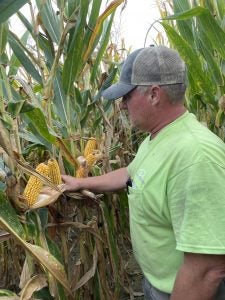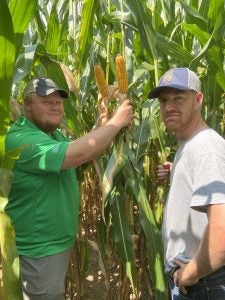Season-long nutrient management driven by corn tissue sampling has delivered tangible returns for Kentucky farmers Chad Porter and Garret Igleheart. The 2022 season marks year six of working with AgriGold Agronomist Josh Johnston to take that sample-based data and make profit-boosting improvements on their farms.
Tissue sampling delivers ROI
“We’re applying the nutrients we need at the right time to further our yields and our return on investment,” Porter says. “If you want to take yields to the next level, you have to figure out what’s working for you and what’s not in terms of nutrients.”
“Thanks to tissue sampling, we’re able to be a lot more efficient,” Igleheart says, adding that the results of their data-driven changes are visible in the corn plant itself. “Giving the plant what it needs when it needs it effectively extends the plant’s lifecycle and grain-fill window, allowing corn plants more time to take advantage of what you’ve done all season and pushing yields over the top.”

Data inspires changes in application timing, nutrient additions
Tissue sampling revealed Igleheart’s operation was starting its fertility program too late. “We had ideas of things we wanted to do and how we wanted nutrients to get into the plant. We thought we had a good side-dress application and didn’t worry about having our soil fertility balanced or adding some pre-plant nitrogen. We were wrong,” he explains.
That program resulted in a slow start for a crop he describes as looking a “little peaked.” Tissue sample analysis drove home the need for a change. “Now, we apply a good slug of nitrogen with sulfur a couple of weeks ahead of planting to build that concentration up in the soil, feeding the young corn plants that have limited root growth at that time,” Igleheart says. “And then we use the planter to band some NPK, boron and zinc 2 to 3 inches off the row.”
We learned you must start right out of the gate with the highest concentration of nutrients as you possibly can and maintain it, Igleheart explains. “Creating that nutrient hot zone for the plant to hit about V3 means the nutrients are in the plant where they need to be at the V5 stage of development to pick up some kernel rows around and boost yield. That turned out to be a lot bigger of a deal than we thought.”
Porter says the tissue sampling-based change that’s delivered the biggest return for his operation was the addition of 10-34-0 (liquid fertilizer that’s 10 percent N and 34 percent phosphate) in the 2X2 while side-dressing nitrogen with y-drops. That has added 6 to 8 bushels per acre in yield with no added expense. “I remove the 10-34-0 cost right out of my DAP budget, dollar for dollar.”
He has also added humic and fulvic acid to his fertility plan, which help corn plants take up nutrients. Porter details, “We put it on with the planter and come back and add it to the mix when we’re y-dropping.”
Porter says tissue sampling prompted him to reevaluate application timing. For example, he had been y-dropping nitrogen in the V8 to VT stage of corn development, but the data signaled nitrogen was needed earlier. Consequently, he now uses several fertilizer applications — before the crop is planted, at planting and two to three y-drop applications all before the V8 window.

Farmers plan to build upon already encouraging results
Porter says his yield curve has accelerated thanks to changes driven by tissue sampling. That sampling also helps farmers tailor their management practices across their farms. “Knowing your soil types and nutrient levels can show you where to push yields and where doing so may not be worth the investment,” he says, adding that knowledge should also inform farmers’ hybrid selections.
“We continue to sample so we can learn new things, try new products and find more things that work to build yield, building off what’s been done in the past,” Igleheart explains.
Igleheart also stresses the importance of following AgriGold’s tissue sampling program that uses a disciplined approach of collecting six samples from precise points in the growing season, measured by growing degree units (GDU): 350 GDU, 750 GDU, 1,150 GDU, 1,750 GDU, 2,000 GDU, and 2,400 GDU. “A lot of people just pull tissue samples at random,” he says, “but they’re only as good as the work you put in.”
Another section of Igleheart and Porter’s tissue sampling journey will be released including 2022 results and plans for the future.


